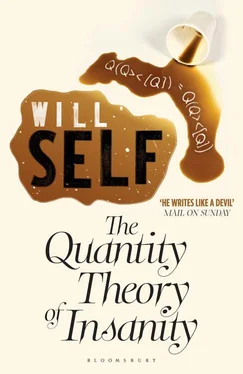And the onion-growers? Well, even though we had to wait to quantify the data, we could see with our own eyes that they had started to exhibit quite remarkably baroque behavioural patterns. With Sid palliated they now not only believed in the beneficial agricultural influence of Ceres, they also believed that Ceres was a real person, who would be visiting them to participate in a celebration of the summer solstice. Some of the really enthusiastic communards even sent out to Lerwick for Twiglets and other kinds of exotic cocktail eatables, all the better to entertain their divine guest.
When we cut down Sid’s medication everything returned to normal. We then went the other way and started introducing minute quantities of LSD into Sid’s diet. The ‘friends’ proliferated. Sid spent all his days in the onion field engaged in a giddy social whirl: cocktail parties, first nights, openings, and house parties. Some of the imaginary friends were even quite well connected. I almost came close to feeling jealous of Sid as he rubbed shoulders with scores of influential — albeit delusory — personages, until my colleagues reprimanded me for my severely unprofessional behaviour.
Needless to say, this part of the experiment was an unqualified success as well. When Sid got madder the communards’ behaviour changed again. They started wandering around the onion field in a distracted fashion. There was no more talk of the imminent arrival of Ceres — instead there was muttering about ‘Going to Lerwick to see about a steady job’. And one or two disconsolate individuals even approached members of the multi-disciplinary team and asked them if they knew anyone who could help them to get into advertising.
We returned to London and conducted a full analysis of our findings. Reducing our calibrated observations and the results of the thousands of psych-profile tests we had conducted on the communards to a series of quotients, we found what we had gone looking for: whatever the fluctuations observed in the behaviour of individuals, the sanity quotient of the group as a whole remained constant.
It became time to publish. Three months later ‘Some Aspects of Sanity Quotient Mechanisms in a Witless Shetland Commune’ appeared in the BJE . There was an uproar. My findings were subject to the most rigorous criticism and swingeing invective. I was accused of ‘mutant social Darwinism’, ‘syphilitic sub-Nietzschean lunacy’ and lots worse.
In the academic press, critic after critic claimed that by proposing that there was only a fixed proportion of sanity to go round in any given society I was opening the floodgates to a new age of prejudice and oppression. Insanity would be rigorously confined to minority and underprivileged groups — the ruling classes would ensure that they remained horrifically well balanced, all the better to foment ‘medication warfare’ against societies with different sanity quotients.
However, the very scale and intensity of the reaction to the theory undercut the possibility of its being ignored. Added to that, my critics became sidetracked by the moral implications of Quantity Theory, rather than by its mathematics. The reasons for this became clear as the debate gathered momentum. No one was in a position to gainsay the findings until our experiments were replicated. And then, of course, they were replicated and replicated and replicated. Until the whole country was buzzing with the audible whirr of pencils ringing letters and digits on multiple-choice forms; and the ker-plunk as capsule after capsule dropped into pointed unputdownable paper beakers: the industry of thought was under way.
That would have been the end of the story. In terms of the naive model of motivation and causation I have set out for you, and then gloriously undermined, I have provided a complete explanation. But we all know what happened next. How the Quantity Theory of Insanity moved from being an original, but for all that academic, contribution to ideas, to being something else altogether. A cult? A body of esoteric knowledge? A political ideology? A religion? A personal philosophy? Who can say. Who can account for the speed with which the bastardised applications of the theory caught on. First of all with the intelligentsia, but then with the population as a whole.
Even if the exact substance of the theory is difficult to define, it’s quite easy to see why the theory appealed to people so strongly. It took that most hallowed of modern places, the within-the-walnut-shell-world of the mind, and stated that what went on inside it was effectively a function of mathematically observable fluctuations across given population groups. You no longer had to go in for difficult and painful therapies in order to palliate your expensive neuroses. Salvation was a matter of social planning.
At least that’s what they said. I never made any claims for the theory in this respect, I was merely describing, not prescribing. It was the members of the group I had assembled to conduct the ground-breaking research who leapt to pseudo-fame on the back of my great innovation. Busner with his absurd ‘Riddle’, and latterly his humiliating game-show appearances, shouting out stupid slogans; Hurst and Sikorski turned out to be incapable of anything but the most violent and irresponsible rending of the fabric of the theory, but that came later. My initial problems were with Harley. Harley the idealist, Harley the kind, Harley the socially acceptable, Harley the therapist.
Some nine months after the revelational paper in the BJE I received a call from Harley who asked me to meet him at his house in Hampstead. I had heard echoes of the kind of work my colleagues had been getting involved in and I had consistently been at pains in my interviews with the press to dissociate myself from whatever it was they were up to. I had my suspicions and I burned with curiosity as I strained on my foldaway bicycle up from the flat I had rented at Child’s Hill to the heights of Hampstead.
The big design fault with these foldaways is that the wheels are too small. Added to that the hinge in the main frame of the machine never achieves sufficient rigidity to prevent the production of a strange undulating motion as one labours to cover ground. I mention this in passing, because I think the state I was in by the time I reached Gayton Road helps to explain my initial passivity in the face of what could only be described as an abomination.
Harley let me in himself. He occupied a large terraced house on Gayton Road. I had known that he was well-off but even so I was surprised by the fact that there was only one bell, with his name on it, set by the shiny front door. He led me into a large room which ran from the front to the back of the house. It was well lit by a wash of watery light from the high sash windows. The walls of the room were stacked with books, most of them paperbacks. The floorboards had been stripped, painted black, and polished to a sheen. Scattered here and there around the floor were rugs with bright, abstract designs woven into them. Thin angled lamps obviously of Italian design stood around casting isolated fields of yellow light. One stood on the desk — a large, flat serviceable oak table — its bill wavering over the unravelling skein of what I assumed to be Harley’s labours, which spewed from the chattering mouth of a printer attached to his computer.
There were remarkably few objects in the room, just the odd bibelot here and there, a Japanese ivory or an Arawak head carved from pumice and pinioned by a steel rod to a cedarwood block. I felt sick with exertion and slumped down on a leather and aluminium chair. Harley went to the desk and toyed with a pen, doodling with hand outstretched. The whine of the machine filled the room. He seemed nervous.
‘You know the Quantity Theory of Insanity …’ he began. I laughed shortly. ‘… Yes, well … Haven’t you always maintained that what is true for societal groups can also be proved for any sub-societal group as well?’
Читать дальше












